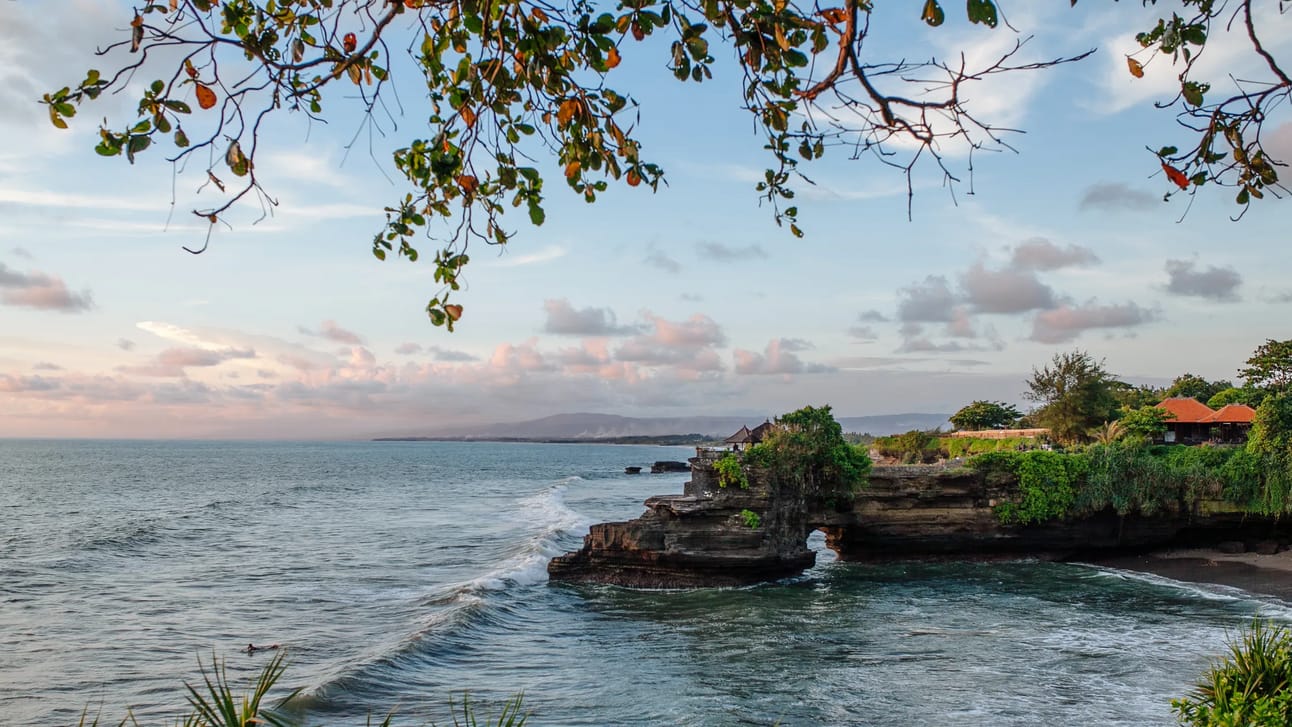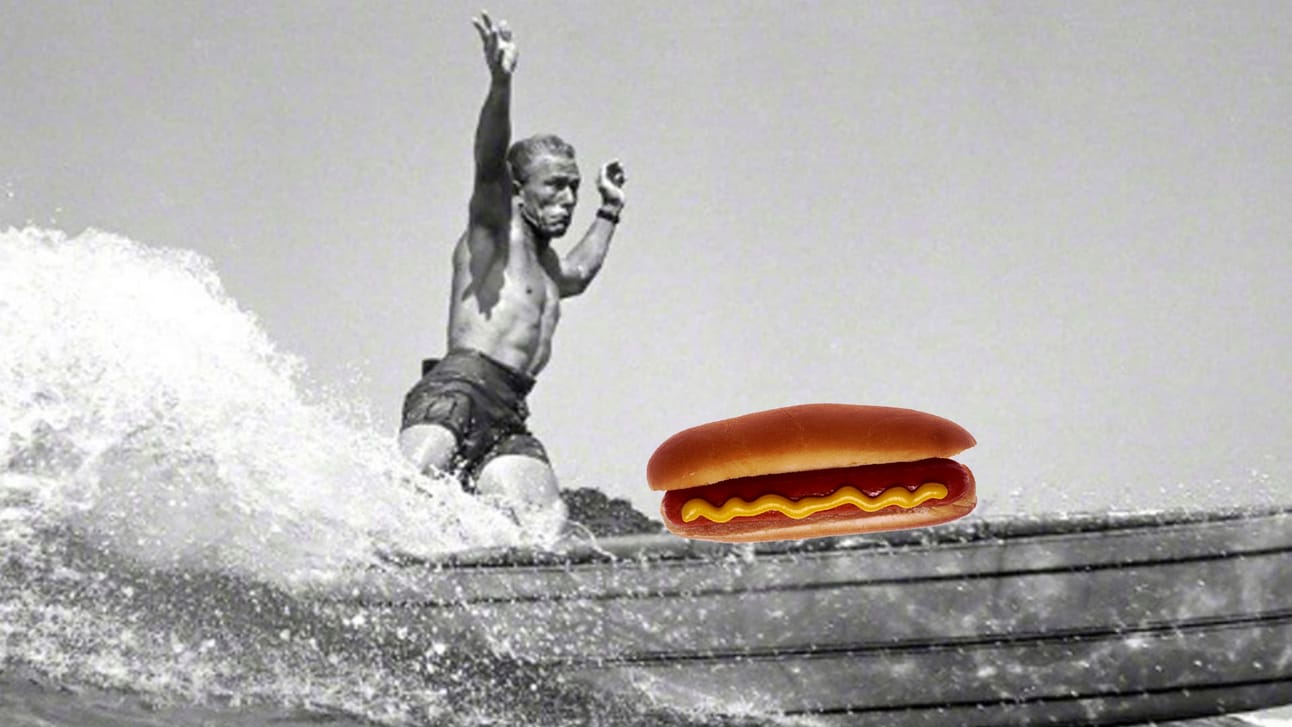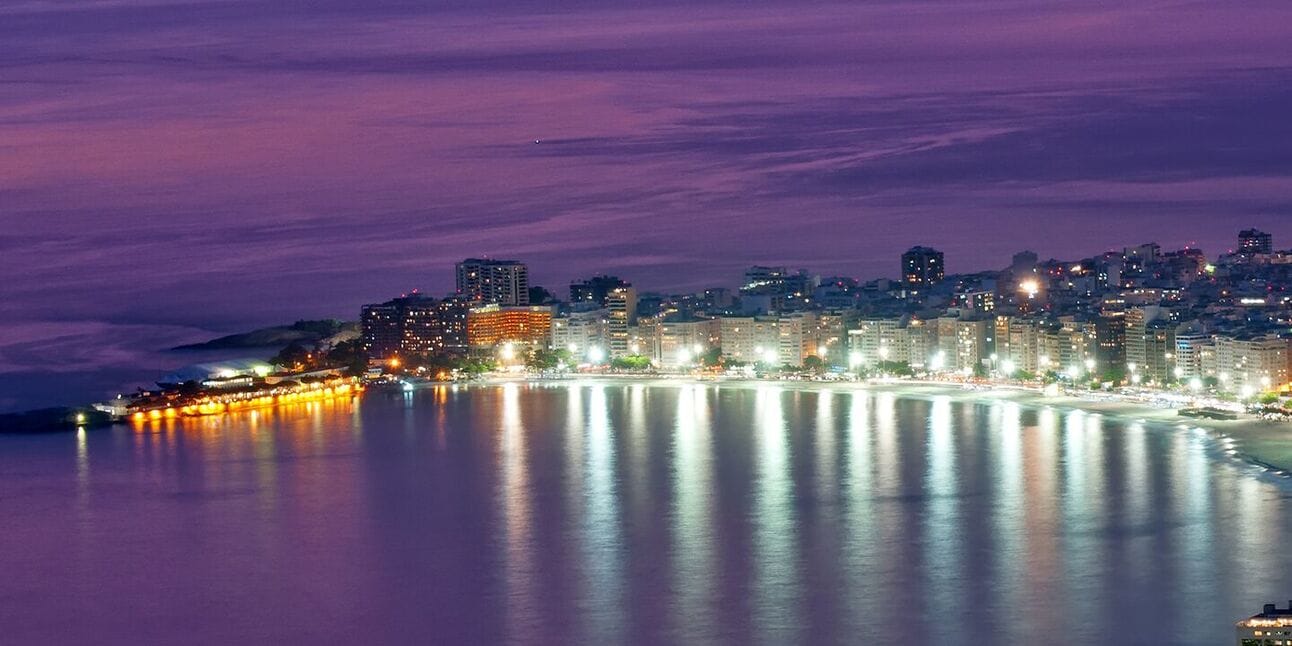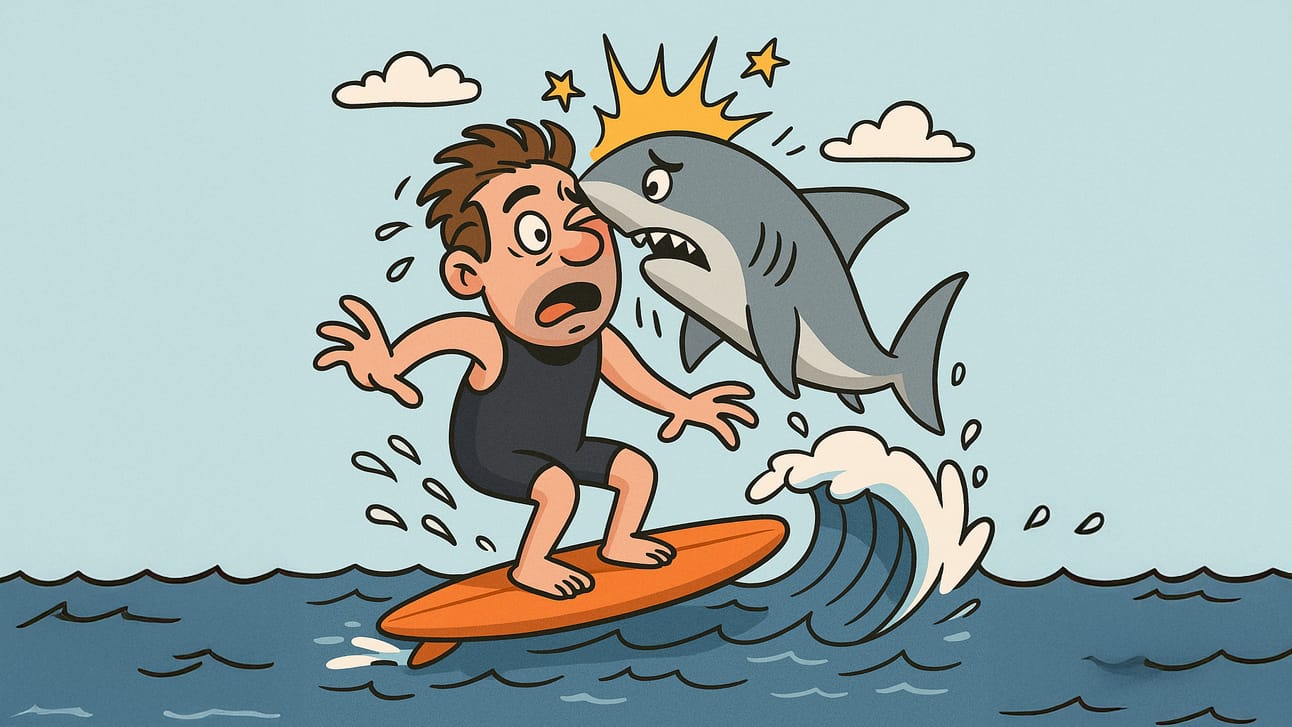- The Wipeout Weekly
- Posts
- 🏄♀️ Dealing with the drop of any size 🗼
🏄♀️ Dealing with the drop of any size 🗼
Plus: Hotdogging, night surfing, this week’s surf news, and beginner tips for Bali

👋 Happy Almost Fourth! If you’re in the USA, you get a day off to surf on account of the nation’s birthday. If you’re outside the USA, you can still surf, of course, and celebrate the birthdays of the actor who plays one of the brothers in Bridgerton, or my mother’s. Dealer’s choice!
🏄♀️ Let’s surf:
Dealing with the drop of any size is a skill 🌊🗼
Batu Bolong—crowded, but tempting 🌴🤙
The best ever word of the week: Hotdogging 🌭
Leveling up with night surfing 🌙✨
The only surf news to pay attention to 🚨
SURFODRAMA
😱 Dealing with the drop of any size is a skill 🌊🗼

Hans Gruber perfected the art of the drop.
Alan Rickman, here playing Hans Gruber in Die Hard—the best Christmas movie ever—was supposed to be dropped 20 feet down onto an airbag on the count of 3. The crew only gave him to 2—hence what should’ve been an Oscar-winning facial expression.
Now imagine someone doing this to you on a 20 ft wave. 😜
This is the moment in surfing that every beginner, and sometimes even experienced surfer, dreads—when the wave lifts, your board tilts down, and for half a second, you question every decision that brought you here.
For the longest time, I have questioned what makes me so terrified of the drop. I have no major problem jumping off a cliff. But when I see that lip rising, the decision to go for it, it’s usually a “no”.
It didn’t used to be like this. I’ve been surfing for quite a few years now. And my experienced surfer friends in NorCal tell me that I could handle the drop ok. Shame, I forgot how.
There are so many potential reasons why you may be scared of the drop.
It could be a physical fear of falling, getting hurt, wiping out, struggling to come up to the surface, being out of breath, getting run over by someone else. That’s a lot to load onto one wave.
I heard this quote: “I hate the drop. I’ll be paddling for a wave and everything is perfect, but as soon as I feel the board tilt—panic. I pull back, or I stand up too late and eat it.”
Relatable? Extremely.
Another surfer shared:
“I don’t even think it’s fear of falling. It’s fear of looking dumb. Fear of being in someone’s way. Fear of being judged.”
Naturally, if you’re just starting out, you may be afraid of looking incompetent, or messing up the lineup for other people, you know “being that person”.
Not to mention this ridiculous existential terror of being seen, being visible. You’re no longer just sitting in the lineup. You’re taking a stand. Everyone’s watching.
Tick all that apply.
What to do, what to do? Here are a few tips.
Practice catching waves on your stomach — get used to the feel of the drop without popping up. This one REALLY works!
Pick the right wave — smaller, slower waves are ideal for drop practice. Some beach breaks are just too steep or fast for confidence building. Probably why I love Waikiki so much.
Pick the right wave part 2 — pick a non-crowded break. You don’t need other people cramming your style.
Visualize it — every time you close your eyes, imagine yourself making the drop, landing it, trimming down the face. Yes, it sounds silly. But if it works for Arnold Swarzenegger (obviously not for surfing), it will work for you.
Surf with friends — it really helps. That’s probably why I could handle the drop in NorCal.
Reframe it — it’s not “the drop.”, there’s no drop, it’s just the thing I do once I catch the wave and before I pop up.
Finally, repeat after me: it’s just water, it’s just water, it’s just so much water. Thank you Tina H. for inspiring this mantra.
SURF SPOT SPOTLIGHT
Batu Bolong, Bali—crowded, but tempting ❤️🔥

I’m off to Waikiki next week, but if I wasn’t I would consider Batu Bolong in Bali. Sounds right up my street, minus the crowds.
Batu Bolong is the main beach in Canggu, about 30 minutes north of Seminyak. It’s known for long, rolling waves that peel gently over a mostly sandy bottom, making it perfect for beginners. The lineup here is always VERY lively—expect a mix of learners, local instructors, and more experienced surfers hunting for something mellow.
🌊 The surf
Batu Bolong is a soft, sloping reef and sand break. The waves break far out and roll in a long, forgiving way that gives beginners plenty of time to get to their feet. If you’re just starting, you’ll probably spend most of your time in the inside whitewater practicing pop-ups. Once you’re ready for green waves, the outside sections can deliver long rides on smaller swells.
It’s very crowded almost every day, especially at mid-tide in the mornings. But if you’re patient—and smile a lot—you’ll still get your waves.
And there’s more baddish news.
🚿 Water quality
Mixed. Bali’s dry season (May–October) tends to be cleaner, but after heavy rains, runoff from nearby rivers can cloud the water and bring debris. If you have sensitive skin, it’s worth rinsing off right after your session.
👙 Wardrobe
Boardshorts, bikinis, or a surf suit are perfect—no wetsuit needed. The water stays around 27–29°C (80–84°F) year-round. Sun protection is a must. The sun here is no joke, so don’t skip your zinc and a good rash guard.
☀️ Best time for beginners to go
April to October is prime time. Dry season brings more consistent swell and offshore winds in the mornings, making conditions cleaner. November to March is the wet season—more rain and onshore winds, but you can still find fun waves if you’re flexible.
⚠️ Hazards
Batu Bolong is beginner-friendly, but there are a few things to watch out for:
Crowds: This is one of Bali’s busiest breaks. Collisions and dropped boards are common.
Longboards: Most people here ride longboards, so always look around before you paddle for a wave.
Reef: It’s mostly sand with patches of reef—be mindful if you fall feet-first.
🏄 Rentals + lessons
You’re spoiled for choice. Dozens of surf schools and beach shacks offer board rentals and beginner lessons. Look for instructors with ISA certification or strong reviews.
🍉 When you’re not surfing
Grab a smoothie bowl or coffee at the local shacks
Watch the sunset with a Bintang in hand at Old Man’s.
Explore Canggu’s boutiques, markets, and yoga studios.
🧳 Solo friendly?
Absolutely. Batu Bolong is a magnet for solo travelers. The vibe is friendly, social, and easy-going. You’ll find surf hostels, co-working spaces, and endless cafes to meet other wave-chasers. Just be ready for the occasional scooter traffic jam and a lineup that feels like rush hour.
WORD OF THE WEEK
Word of the week is hotdogging 🌭

Dewey Weber and his hotdog out surfing.
Hotdogging is a term from the golden age of surfing—roughly the 1950s and 60s—that described a flashy, highly maneuverable style of riding, usually small waves. Hotdoggers were surfers who didn’t just ride waves straight to shore or perform the classic “trim”—they performed radical turns, noserides, drop-knee cutbacks, walk-the-board footwork, and other tricks that showed off their control and flair.
🎪 Quick side note
Before hotdogging, surfing always had its circus (I say circus with love) performers, such as Waikiki surfer John Hawkshaw Paia, who in the 30s was doing headstands on the board, somersaults, and spinners.
🏄♂️ The name, the father…
You kinda get now why it’s called hotdogging, right? The slang “hotdog” was common in American sports as early as the 1920s, meaning a show-off or someone who performs flashy tricks. Think of it like calling someone a "showboater" today.
But who was the father of hotdogging, the hotdogging father, the big Hot Dog? Depends whom you ask.
You ask Sports Illustrated and it’s Phil Edwards who, I quote:
“One day, quite by accident, he rode into the curl of a wave, and modern ‘hot dog’ surfing was born.”
But if you ask Matt Warshaw of the Encyclopedia of Surfing, he will tell you it was Dewey Weber, who was famous for his drop-knee cutbacks and invented hotdogging. Dewey used to ride a wide-backed pig, easier to turn than the Malibu chip, and he could whip through as many as 6–8 90-degree turns per wave. It did help that Dewey was small and light—he stood at 5’3’’. Both of these features make sense when you learn that he was called “the little man on wheels.” His fashion sense was also cool. He bleached his hair white, wore red trunks, and rode red surfboards.
🤸♂️ Classic hotdogging maneuvers
I’m stealing this from the Encyclopedia of Surfing:
The head-dip – where a surfer bends over and dips his head in the curl.
The spinner – a pirouette, performed two or three times.
The fin-first takeoff – where you start the ride with the surfboard tail first and then you quickly slide it 180 degrees.
A couple of hunched-over positions, including the butterfly and the quasimoto.
Oh, and Gerry Lopez actually got noticed because of his sidelip, a hotdog move where the surfer bends over, jams a hand in the water, and drops sideways down the wave face.
No wonder, according to Dewey, hotdogging is the only style of surfing that allows the surfer to express himself as an individual.
SURF SKILLS
Leveling up with night surfing 🌚🏄🏻♀️

The lights do help.
I can totally get behind the idea of surfing at night for one very simple reason: no people. This just sounds absolutely glorious.
Funnily enough, that’s not how night surfing started. Night surfing used to be plenty crowded.
It’s as old as modern surfing itself. Back in 1909, Alexander Hume Ford, a travel journalist somewhat obsessed with surfing who settled in Hawaii in 1907, mentions a feature of the annual Waikiki carnival where surfers attached acetylene lamps to their boards and surfed at night. “To ride the breakers in the circle of the light,” he said.
🌕 How it’s done today
Today, night surfing is usually done during the full moon, at easier-to-ride breaks such as Malibu, Rincon, and Trestles. In Huntington Beach, surfers used the lamppost light off the pier. The city was so nice, it even adjusted the wattage in the late 60s.
It’s not always so gentle, though. Apparently, Hawaii’s surfer Jock Sutherland became a legend of night surfing 20-foot waves at Waimea while high on LSD. It’s not something we’d recommend.
🏄♂️ Want to try it? Read this first
First, pick a beach that allows it, because some don’t. Preferably a break you’re very familiar with. And choose a good night for it, with a full moon when the ocean glows. Or a break with floodlights nearby.
I could mention wave pools with night sessions, but I won’t. Because you know—not really night surfing.
Obvious—do not surf alone. Be aware that visibility, even in moonlight, is limited; you’ll be guessing where that next wave is breaking and where anything is, because all the landmarks disappear, and it’s easy to drift without realizing.
Oh, and sharks—they are more active at night. Be as visible as possible, so do use glow-in-the-dark leashes or LED board lights, and any high-visibility gear you can wear. Make your position known by yells or whistles, so you don’t collide with other surfers.
🌅 Best tips for beginners
The best idea for any beginner is to start with a sunset session and let it ease into twilight. Slowly slowly catchy monkey.
Or you can try Arpoador Beach in Rio de Janeiro, where you can surf 24 hours a day thanks to the stadium lights on the boardwalk.
One last thing: when you’re night surfing, it will feel like you’re going faster!
THE WIPEOUT WEEKLY SURF NEWS ROUNDUP
The only surf news worth paying attention to

Pro surfers go brand-collab nutso crazy at $6,500 and $250,000 a piece
The Wave is back on, supposedly. We don’t know who to believe anymore.
Weligama’s surf structures demolished, gone forever.
Man head-butted by a shark
Make a Wave gonna surf 30 days non-stop, and you can too.
⬆️ Aaaaaaand that was the last wave of the week!
If a friend forwarded this and you liked it, hit subscribe & join us! We will see you all next week! 🌊
🏄 How was this week's edition of The Wipeout Weekly?Drop in with your pick 👇 |

Reply